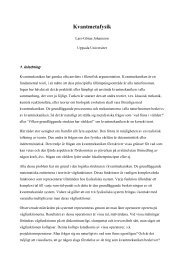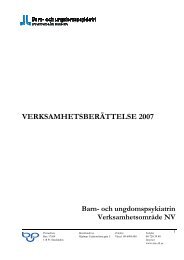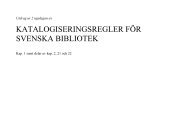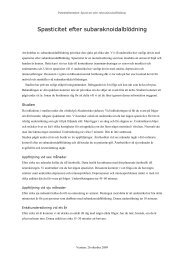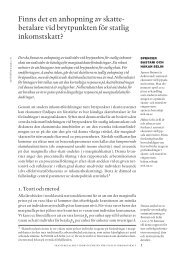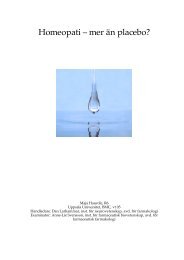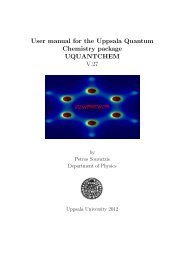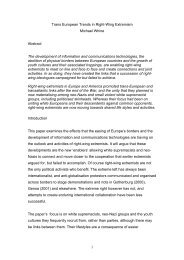A Hindi grammar and dictionary, Western style, composed around ...
A Hindi grammar and dictionary, Western style, composed around ...
A Hindi grammar and dictionary, Western style, composed around ...
Create successful ePaper yourself
Turn your PDF publications into a flip-book with our unique Google optimized e-Paper software.
A <strong>Hindi</strong> <strong>grammar</strong> <strong>and</strong> <strong>dictionary</strong>, <strong>Western</strong> <strong>style</strong>, <strong>composed</strong> <strong>around</strong> 1700. A short<br />
report on two manuscripts in Rome <strong>and</strong> Paris.<br />
A Catholic missionary who is less well known, but nevertheless well worthy of attention, <strong>and</strong> who<br />
preached in India with a mind also open to the culture of the country, was François-Marie de Tours,<br />
of the French Capuchin Order. His missionary work in India lasted at least twenty years beginning<br />
in the 1680s. His main station was located at the important Moghul commercial town Surat in<br />
Gujarat, on the west coast of India. While fulfilling his commission he also had close ties with other<br />
French missionary stations in India, especially the one at Pondichéry in the southeast, as evidenced<br />
by various records. He is mentioned now <strong>and</strong> then in written works, mostly passim <strong>and</strong> in footnotes<br />
to scholarly tracts on wider topics, <strong>and</strong> most of these references concern two of his many activities<br />
<strong>and</strong> capacities. 1<br />
This first is, that François-Marie wrote a pamphlet against his Jesuit missionary brothers. This was<br />
printed in 1704 through by Sacra Congregatio de Propag<strong>and</strong>a Fide (henceforward CPF), the<br />
institution in Rome responsible for sending Catholic missionaries to different parts of the world. At<br />
that time there had been a flare-up of the long-st<strong>and</strong>ing conflict between various groups of<br />
missionaries in India concerning the extent to which the Christians could adapt to the native<br />
customs, <strong>and</strong> the issue concerned the debate on the so called Malabar rites. The pamphlet criticizing<br />
some of the Jesuit practices in pursuing missionary work was presented by François-Marie himself<br />
to the CPF in 1703.<br />
The second project was one that he independently proposed to the Congregatio during his same visit<br />
to Rome, namely that three new missions should be established in India: one as an extension of the<br />
one in Gujarat <strong>and</strong> Sindh, one in Bijapur <strong>and</strong> Golconda <strong>and</strong> one in Tibet. The two proposed<br />
missionary assignments to "Gujarat e Sindh, l'altra a Bijapur e Golconda" never came about, only<br />
the third one to Tibet was approved by the Holy See. The Capuchin order was commissioned for the<br />
task <strong>and</strong> it was decided that Lhasa would be made a branch of the mission in Ch<strong>and</strong>ernagore. The<br />
result was that François-Marie 2 was appointed to the group charged with fulfilling this commission.<br />
Certain documents concerning this project are available, including letters he wrote himself, <strong>and</strong><br />
from the records it is well known that this enterprise was, in spite of the loss of many members of<br />
the original expedition, successfully accomplished by François-Marie <strong>and</strong> an Italian Capuchin<br />
brother Giuseppe da Ascoli. 3 We also know that this enterprise was François-Marie's final<br />
undertaking, since he died in 1709 in Patna on his way back to Surat.<br />
1<br />
His activities are recorded in various archives of the Catholic mission in Rome; available, unpublished records of the<br />
kind date back to <strong>around</strong> the shift from the 17th to the 18th century. For a further more detailed survey of the records,<br />
see forthcoming works by Paolo Aranha.<br />
2<br />
"der unternehmungslustige P. François-Marie de Tours." A. Jann, Die katholischen Missionen in Indien, China und<br />
Japan. Paderborn 1955, p. 387 etc.<br />
3<br />
The enterprise is well documented in detail as far as the sources allowed him by Luciano Petech, Il nuovo Ramusio, II,<br />
I missionari italiani nel Tibet e nel Nepal, Parte I, I cappuccini Marchigiani, Roma 1952.<br />
1
Apart from these two activities François-Marie de Tours deserves to be recognized for yet another<br />
activity of great importance that has practically been neglected, even though it was recorded in the<br />
Acta of the Congregatio as presented by him in Rome He undertook an ambitious linguistic<br />
enterprise, the results of which are only sparsely mentioned in some surveys from the 18th century,<br />
while in more recent times this third qualification of his is briefly stated in the major work by<br />
Luciano Petech about the Tibetan mission, especially the Italian one. 4<br />
Ma oltre a questo scopo, per quale egli era stato inviato in Europa, egli ne perseguiva altri due. L'uno<br />
era che la Congregazione si assumesse l'onere di far stampare una grammatica e due dizionari<br />
hindustani da lui complilati; egli non riuscì nell'intento ed i suoi manoscritti rimasero nella Biblioteca<br />
di Propag<strong>and</strong>a, dove esistevano ancora nel 1792; oggi se ne son perdute le tracce.<br />
Together with other evidence it can be clearly be established that François-Marie was a dedicated,<br />
active, <strong>and</strong> rather prolific linguist. Apart from his interest in Indian languages there are some as yet<br />
unconfirmed hints that he knew Arabic <strong>and</strong> Persian. He is told to have acted as an interpreter of<br />
these languages, presumably skilled, since his first posts as a missionary are reported as having<br />
been in Diyarbakir <strong>and</strong> Persepolis. His skill <strong>and</strong> experience in linguistic matters is furthermore<br />
indicated by the fact that during his rather brief stay in Tibet he worked together with Ascoli on<br />
both a <strong>grammar</strong> <strong>and</strong> a <strong>dictionary</strong> of Tibetan. 5 In a letter in his own h<strong>and</strong> sent from Lhasa in 1708 he<br />
also mentions that in Tibet he uses "la lingua indiana, la lingua turchesca ci puol'anco ben servire<br />
tra li Kalmaks, che sono li Tartari" 6 .<br />
The most impressive works by his h<strong>and</strong>, however, have not been edited, namely those mentioned by<br />
Petech as being lost: an extensive <strong>grammar</strong> <strong>and</strong> a major <strong>dictionary</strong> of <strong>Hindi</strong>, both completed in<br />
Surat in 1704, <strong>and</strong> which he himself testifies in his presentation to the Congregatio in Rome that he<br />
had worked on during his twenty years of missionary service in India.<br />
Such manuscripts written in his own h<strong>and</strong> actually are mentioned from time to time in scholarly<br />
tracts over the centuries, <strong>and</strong> as late as the 1790s are described as really existing, but later only as<br />
recorded in the minutes of the CPF. It is the existence of a <strong>dictionary</strong> that has repeatedly been<br />
alluded to in scholarly literature; while the <strong>grammar</strong>, as an independent work, seems to have been<br />
forgotten as early as the beginning of the 18th century.<br />
Reliable as he is, Luciano Petech, the scholar quoted above, must nevertheless be contradicted<br />
today. Now, 300 years later, it is possible to reunite the entire work on <strong>Hindi</strong> language written by<br />
François-Marie. Two manuscripts in different locations are clearly two separate, but linked works<br />
by his h<strong>and</strong>, one <strong>grammar</strong> <strong>and</strong> one <strong>dictionary</strong>, the latter in two parts, of <strong>Hindi</strong>, authentic as they<br />
4 Petech 1952, Introduzione, p. XXXV.<br />
5 Petech, pp.XCI-XCII. The <strong>dictionary</strong> based on Latin vocabulary was later completed by P. Domenico da Fano, the<br />
responsible missionary successor to François-Marie in Lhasa, also of the Capuchin order, <strong>and</strong> was brought to Rome by<br />
him in 1714. It is clearly the first European lexical work on Tibetan. It was stated to be lost until in by Petech (p. XCI)<br />
was confirmed to exist among the Tibetan manuscripts in Paris, Bibliothèque Nationale de France (Fonds Tibétain 542).<br />
The material it contains was probably used in later printed Tibetan dictionaries. Regarding a Tibetan <strong>grammar</strong>, only an<br />
introductory grammatical section of the <strong>dictionary</strong> is mentioned in later sources.<br />
6 Petech, p. 39.<br />
2
existed at the beginning of the 18th century. Both manuscripts, most probably written in François-<br />
Marie's own h<strong>and</strong>, <strong>and</strong> both of impressive quality <strong>and</strong> the greatest scholarly interest, are more than<br />
worthy of being solidly edited <strong>and</strong> discussed from a great number of perspectives, since they offer a<br />
wealth of new historical <strong>and</strong> linguistic data of interest for areas including Indology in general, the<br />
history of the <strong>Hindi</strong> language, Missionary history, <strong>and</strong> India's relationship to Europe in earlier<br />
times.<br />
The <strong>grammar</strong> is still located in the Archivio Storico of CPF in Rome. This <strong>grammar</strong> can certainly<br />
compete with other works claiming to be the first <strong>grammar</strong> for the <strong>Hindi</strong> language. I was lucky to<br />
get it under my eyes, having heard from a colleague at Uppsala University that she had seen<br />
something obviously Indian in a composite volume of manuscripts during a visit to the Archive.<br />
What I saw during my March 2011 visit was a <strong>Hindi</strong> (Hindustani) 7 <strong>grammar</strong> containing 74 leaves<br />
(148 pages), written in Latin, using Devanagari for <strong>Hindi</strong> words, <strong>and</strong> following the form <strong>and</strong> the<br />
dem<strong>and</strong>s of a <strong>grammar</strong> in the classical tradition common at the time. Thus it must be defined as a<br />
scholarly <strong>grammar</strong>, fully revealing the linguistic awareness of the author, <strong>and</strong> containing both<br />
linguistic discussions <strong>and</strong> a large number of paradigms. For further description of the manuscript,<br />
see Appendix 1.<br />
Since there were clear signs that a Thesaurus had previously been part of the same volume, 8 I made<br />
my efforts to find it mentioned somewhere <strong>and</strong> in reality. With a vague idea that the author's<br />
background as a French missionary of the Capuchin order from Tours might cause the trail of the<br />
lost <strong>dictionary</strong> to lead to France, I visited Paris March 2012 to search in archives <strong>and</strong> libraries. The<br />
very comprehensive library of the Capuchins at Montparnasse was unfortunately short on<br />
manuscripts, due to the Revolution of course. But amazingly, at the Department of Oriental<br />
manuscripts at the Bibliothèque Nationale de France, the hoped-for localization of the Thesaurus<br />
became clear!<br />
Habent sua fata libelli! The fate of the Thesaurus has evidently been as follows. At the request of<br />
the well known orientalist Abraham Hyacinthe Anquetil-Duperron (1731-1805) the <strong>dictionary</strong> was<br />
sent in 1784 from the Sancta Sedes in Rome to Paris. Anquetil's own h<strong>and</strong>written testimony<br />
describing his intention <strong>and</strong> the entire event is found in a letter enclosed <strong>and</strong> pasted into the Paris<br />
manuscript. He tells that he had already spotted the <strong>dictionary</strong>, or probably a rough copy of it, in<br />
1758 in Surat, while he was there working on his translations of Zoroastrian texts. In the 1780s he<br />
7 At present I leave out the terminological discussion on the designation of the language that also held other<br />
contemporary names. In it <strong>Hindi</strong> it does not necessary at the outset to account for the varieties <strong>and</strong> the nuances of the<br />
name of the language, nether in the empirical nor in the scholarly tradition. It is used as a catchall term e.g. by Tej<br />
K.Bhatia whose work in the H<strong>and</strong>dbuch der Orientalistik from 19877 on the subject is entitled A History of the<br />
<strong>Hindi</strong> Grammatical Tradition, with the subtitle <strong>Hindi</strong>-Hindustani Grammar, Grammarians, History <strong>and</strong> Problems.<br />
8 At the bottom of p. 35v (older h<strong>and</strong>-written pagination), as a catch-word for the following page, the manuscript in<br />
Archivio Storico has THESAV, which is not what follows in the volume. It also seems clear from a noticeable gap<br />
between the pages that some pages have been removed. In the following regular <strong>grammar</strong>, in the volume at CPF's<br />
archive, the h<strong>and</strong>-written pagination starts anew, but the sequence of the pagination with stamped figures does not,<br />
which proves that the pages are stamped after the removal of the <strong>dictionary</strong>. See also the description of the manuscripts<br />
in Appendix 1.<br />
3
came across a reference, 9 pointing to the existence of such a <strong>dictionary</strong> in the Archives of CPF; he<br />
presumed that this was precisely the one he had seen in Surat. Anquetil, who deeply regretted not<br />
having been able to copy the <strong>dictionary</strong> already in Surat, wrote to the CPF asking for a loan with the<br />
promise to make an edition of the work. The loan was granted from Rome by the Pope. The clerks<br />
at the Archive apparently decided only to send the <strong>dictionary</strong> to Paris, <strong>and</strong> probably even removed it<br />
from a then existing volume, as it is still possible to conjecture by the gap in the Rome manuscript.<br />
But the providers in Rome, did not send the supplementary introduction to the <strong>dictionary</strong>, consisting<br />
of a title page, a very well-written Praefatio (4 pages) <strong>and</strong> a thorough "grammatical" introduction to<br />
the phonology (15 pages). This introduction was never known by Anquetil-Duperron <strong>and</strong>, as he<br />
tells in his letter, lacking an aid for the reader he found it necessary himself to add a short<br />
introduction on the alphabet to the <strong>dictionary</strong> in the condition he received it from Rome.<br />
By now it is necessary to reunite the grammatical introduction in Rome with the <strong>dictionary</strong> in Paris<br />
in order to do credit to François-Marie of the whole work. The fact is, Anquetil-Duperron neither<br />
made an edition of the <strong>dictionary</strong>, seemingly the loan was not returned. 10 Anquetil did however<br />
make a copy of the entire <strong>dictionary</strong>, which is now available (MS 839) together with the original<br />
(MS 840) in the collection of Oriental manuscripts at Bibliothèque Nationale de France. He clearly<br />
made the copy as a preparation for printing, an intention that is mentioned in some of his<br />
biographies. It is also recorded that his long-st<strong>and</strong>ing plan to publish the <strong>dictionary</strong> collapsed due to<br />
a conflict with his publisher in his final years.<br />
Thanks to the detailed account written by Anquetil himself, the story of the <strong>dictionary</strong> - which also<br />
accounts for some changes he made in the text - is clear up to 1784, but many points must be further<br />
investigated for the time following, especially if the manuscript was not returned to Rome or not. 11<br />
It might be mentioned that Anquetil does not seem to have been very interested in the question of<br />
the author's identity <strong>and</strong> circumstances. Nevertheless, even his copy of the <strong>dictionary</strong> includes at the<br />
end a rescript of a concluding, probably original document from the original manuscript: a survey in<br />
Italian comprising two pages about the "Autore, e Scrittore del presente Libro". It is dated 5 July<br />
1704 <strong>and</strong> undersigned by C.A. Fabronus, secretary of the Congregation as received by Franciscus<br />
Maria (all by the same h<strong>and</strong>). On the same leaf a short note has been added, dated 1771, written by<br />
the secretary Stefanus Borgia, stating that the <strong>dictionary</strong> was revised that year by P. Cassiano di<br />
Macerata, Capuchin missionary in Tibet.<br />
9 The reference was made in 1771 in a preface to a publication by Sacra Congregatio de Propag<strong>and</strong>a Fide about the<br />
typography of Indian alphabets: J.C. Amadutius, Alphabetum Brammhanorum.<br />
10 It has been indicated to me that a suggestion soon will be published that it really was returned but made its way back<br />
to Paris as part of the Secret Archive of the Vatican as confiscated by Napoleon in 1810. If this interesting hypothesis is<br />
well-founded it must also be noted that the <strong>dictionary</strong> belonged to the part of the Archive that was restored 1814 at the<br />
defeat of Napoleon.<br />
11 A special notice in a publication from 1792, tells that it was available in Rome after 1784. See Paulinus a S.<br />
Bartholomeo, Examen historico-criticum codicum Indicorum Bibliothecæ Sacræ Congregationis de Propag<strong>and</strong>a Fide,<br />
Rome 1792, pp. 57-60. There is also a note requiring further investigation that states that at some time the volume<br />
belonged to the German orientalist J. Klaproth (1783-1835, residing in Paris from 1815). It is on a label at the beginning<br />
of the original MS 840.<br />
4
The presentation of these two manuscripts of greatest value touches on at general issue that<br />
deserves discussion. Any claim about a product created by human beings that it is the "first" of its<br />
kind is fraught with risk. In general, such an argument could always be labelled an argumentum e<br />
silentio. Furthermore the definition of any item has to be carefully qualified. In this case it is<br />
necessary to clearly determine which of many types of <strong>grammar</strong>s <strong>and</strong> dictionaries are meant. 12 How<br />
to label written texts, whether they take the form of manuscripts or published texts, must also be<br />
taken into account before relating them to others in any respect, including their place in a historical<br />
sequence. The setting of the texts must also be evaluated with reference to their later impact.<br />
At this point no claims will be made as to the position within a time-line of the manuscripts<br />
presented here beyond the statement already made that two very valuable <strong>and</strong> original manuscripts<br />
are available for an edition. Belonging as they do to an early period in the history of the <strong>Hindi</strong><br />
language, they are worthy of close attention by indological scholars.<br />
12 A cursory glance makes it clear that the <strong>grammar</strong> presented here <strong>and</strong> the recently rediscovered <strong>grammar</strong> by J.J.<br />
Ketelaar, a merchant in Dutch service who was stationed in the same part of India at about the same time as François-<br />
Marie, that the two <strong>grammar</strong>s definitely are not of the same type. Bhatia, Tej & Kazuhiko, Machida, The oldest<br />
[European] Grammar of Hindustani Language. Contact <strong>and</strong> Colonial Legacy. 3 vol. Tokyo (Tokyo University) 2009.<br />
Cf. http://bc.library.uu.nl/node/180. François-Marie's <strong>grammar</strong> was written by a monk schooled in the tradition of<br />
Donatus, <strong>and</strong> his <strong>dictionary</strong> contains only semantic information, in a tradition of Thesauri still living today in modern<br />
lexical works. Ketelaar's <strong>grammar</strong> could just as well be defined as a linguistic h<strong>and</strong>book for practical use, <strong>and</strong> it follows<br />
a certain lexical tradition of <strong>grammar</strong>s. When it comes to studying the Hindustani language of their time, the two works<br />
will certainly be complementary to each other.<br />
5
Appendix 1<br />
A page-by-page description of the contents of the two manuscripts, a <strong>Hindi</strong> <strong>grammar</strong> <strong>and</strong> a <strong>Hindi</strong><br />
<strong>dictionary</strong>, available in Rome <strong>and</strong> Paris respectively.<br />
THE ROME MANUSCRIPT<br />
The manuscript found in the Archive of the Congregatio de Propag<strong>and</strong>a Fide forms part of a volume of<br />
manuscripts labelled as Vol XII Miscellanea, in which the leaves are continuously numbered with a stamp as<br />
302-399 on the recto-side of each leaf. 1 Most pages of the part presented here also have a h<strong>and</strong>written<br />
number on each individual page, probably in the h<strong>and</strong> of the original scribe; when such numbers are missing<br />
it seems to indicate that the work was not quite finished. 2 The preceding <strong>and</strong> following pages in the volume<br />
of manuscripts contain mixed texts. These are mainly letters, mostly in Latin, <strong>and</strong> some material in Italian. It<br />
can be mentioned that the pages stamped 425-465 contain outlines of various alphabets.<br />
Primarily the earlier, individual numbering of each page evidences that it is a question of two more or less<br />
separate works; but there are other indications as well. The manuscript should therefore rightly be treated as<br />
two separate works as follows.<br />
1) After the title page with Devanagari characters 3 there follow 16 leaves containing an introduction <strong>and</strong> an<br />
exhaustive exposition of the writing under a heading indicating that this is the initial part of an Indian<br />
<strong>grammar</strong>. These leaves are stamped with the numbers 306-321, but are also numbered by h<strong>and</strong> with the<br />
individual numbers 5-36. On the last one (page 36 = 321v), a catch-word at the bottom of the page (with the<br />
text THESAV) indicates that something else will follow than what is now at h<strong>and</strong>, is titled "Grammatica<br />
Mogolana". 4<br />
2) Hereafter follow 4 unnumbered leaves, two simply containing written titles in Latin, the reverses of them<br />
being blank. The older h<strong>and</strong>written pagination (74 leaves stamped with the numbers 326v-399v) runs from 1<br />
to 119, after which follow 25 more unnumbered pages with clearly related content (obviously meant to be<br />
numbered 120-144).<br />
It is clear that the first part, no. 1, was intended to "grammatically" introduce the missing <strong>dictionary</strong>, while<br />
the second part, no. 2, is an independent, more or less complete <strong>grammar</strong>. Henceforward these two items will<br />
be referred to as MS 1 Rome <strong>and</strong> MS 2 Rome respectively.<br />
1<br />
See Kowalsky, N. & Metzler, J., Inventory of the Historical Archives of the Congregation for the Evangelization of<br />
Peoples or "De Propag<strong>and</strong>a Fide". Roma (3. ed.) 1988. More precisely this volume of Miscellanea is, according to the<br />
inventory, part II of the volumes Miscellanee Pastrizio, Kowalsky & Metzler p. 76. In the following description of the<br />
MS the stamped numbering will be used together with the notation r (recto) <strong>and</strong> v (verso) respectively.<br />
2<br />
The h<strong>and</strong>written numbering seems to be 1-35, followed by 1-119 (144), see below.<br />
3<br />
Illustration A.<br />
4<br />
The sequence of pages originally numbered by h<strong>and</strong> will most probably confirm that the Thesaurus initially had its<br />
proper place in the obvious gap, which is not marked by the later numbering of the pages by stamp; at present an<br />
ordered digital copy of the Thesaurus in Paris has been ordered but is not yet available to me. The kind <strong>and</strong> the size of<br />
paper will also be compared.
MS 1 Rome (302-321,the introduction to the Thesaurus) is written on a rather stiff paper, of somewhat larger<br />
size than the following part, with thin margins drawn on the pages; the writing is easily legible, almost block<br />
letters.<br />
MS 2 Rome (322-400, the regular <strong>grammar</strong>) is written on thinner paper of smaller size than the preceding<br />
part of the manuscript, with powerfully drawn margins (sometimes cutting through the paper); the writing is<br />
in a swifter cursive <strong>style</strong>.<br />
MS 1 Rome<br />
Grammatical introduction to the THESAURUS (301 -321, old, h<strong>and</strong>written pagination [1]-36)<br />
1) The (unnumbered) title page is written in Devanagari (with a certain presumably local variation of the<br />
characters, but quite in accordance with the characters used in the following pages when analysing the<br />
alphabet).<br />
This page needs further analysis, but so far it is obvious that after the introductory invocation to the Lord (srī<br />
khodāhkā nāṁsaṁ) the contents of the following work are indicated as comprising a thesaurus (khajāna),<br />
<strong>grammar</strong> (āvyākaraṇa) <strong>and</strong> writing (lekhaṇa). The name of the author is given in the line before IHS MA<br />
<strong>and</strong> the date (the year 1703 barsamhe) in the following line.<br />
2) There follows a preface by the author describing the coming into being of the <strong>grammar</strong> <strong>and</strong> the <strong>dictionary</strong><br />
as well as the scope of the work (306r-307v, old pagination 5-8) under the heading:<br />
In Thesaurum Linguae Indianae seu Mogolanae<br />
Praefatio
3) The grammatical survey that follows (308r-318v, old pagination 9-35), which is limited to the alphabet<br />
<strong>and</strong> pronunciation, is introduced by a second preface (308r-v, old pagination 9-11) about the languages of<br />
India <strong>and</strong> the usefulness of the work. 5<br />
See appendix 2 for the Latin text <strong>and</strong> a translation<br />
In Grammaticam Indianam Praefatio<br />
4) The main grammatical part of the introduction to the Thesaurus itself (309r-317v) is divided into ten<br />
chapters followed by a table of the alphabet, all of which come under the subtitle:<br />
Indianae Grammatices Pars Prima 6 .<br />
De Litterarum Caracteribus. Caput I (309r-310v)<br />
De Litteris in generali. Caput II (310v-311r)<br />
De Pronuntiatione Litterarum in coi (communi). Caput III (311r-311v)<br />
De pronuntiatione Litterarum in particulari. Caput IV (311v-314r)<br />
Comparatio alphabeti Indiani cum Latino. Caput V (314r-314v)<br />
De Litteris Componendis, et Coniugendis. Caput VI (314v-315v)<br />
De Litteræ Anomalæ "r" Scriptione. Caput VII (315v-316r)<br />
De litteris finalibus. Caput VIII (316r)<br />
De Vocalibus, et dyphtongis. Caput IX (316v)<br />
De Syllabis. Caput X (317r-317v)<br />
Tabula Syllabarum Compositarum. (318r-v)<br />
5) A short introductory note to the <strong>dictionary</strong> follows (320r):<br />
Proemium. Quaedam praenot<strong>and</strong>a pro Thesauri Indiani majori Illuminatione (320r)<br />
6) A summary table of the alphabet is added:<br />
Tabula Litterarum, earumque vernaculis caracteribus demonstrata diff(erent)ia (320r-321r)<br />
concluded by a "reminder"<br />
Monitum (321r)<br />
The reverse of 321 is empty; at the bottom is written the catch-word THESAV is written, which concludes the<br />
introductory part of the <strong>dictionary</strong>.<br />
5 This part of the preface bears a very close resemblance to the main preface in the <strong>grammar</strong>, MS 2 (326r-327v), in<br />
which latter context the table of contents directly follows. The relationship between the two, which are written by<br />
different h<strong>and</strong>s, will certainly give clues about the genesis of the two items, the <strong>dictionary</strong> <strong>and</strong> the regular <strong>grammar</strong>.<br />
6 The first part, entitled pars prima is not followed here by any other partes. It is, however, quite similar throughout to<br />
the first part (stamped pages 332v-346r) of the more complete <strong>grammar</strong>, Ms 2 Rome, the contents of which are<br />
described below <strong>and</strong> in which parts 2-5 also follow. The version of this first part of the <strong>grammar</strong> when used for the<br />
Dictionary is more neatly written, <strong>and</strong> the language is more consistent than the counter-part, the first Chapter of the<br />
regular Grammar. By copying the first part of the Grammar as introduction to the Dictionary, the author most likely<br />
wanted to stress the affinity of the two works. An evaluation of the relationship between the two similar texts remains to<br />
be done.
MS 2 Rome<br />
The regular <strong>grammar</strong> (322r-399, old h<strong>and</strong>-written pagination written on page 1-119 (p. 120-144 pages not<br />
inscribed). Two title pages:<br />
322r<br />
Grãmatica Mogolana<br />
This preliminary title page is simply written, not by the same h<strong>and</strong> as the main title page in MS 1; the second<br />
title page also seems to be more or less a draft, though probably by the same h<strong>and</strong> as MS 1:<br />
323r<br />
Grammatica Linguae Indianae Vulgaris sive Mogolanae authore fratre franciso Maria Turonensi<br />
Capucino.<br />
326r The <strong>grammar</strong> is introduced:<br />
followed directly by (326v-327v)<br />
Miss rio aptico<br />
IHS MARIA<br />
Anno Dni 1704<br />
Ad Benevolum Lectorem<br />
Praefatiuncula<br />
In novam Linguae Indianae seu Mogolanae<br />
Gramaticam breve totius operis Compendium<br />
The text of this part of the introduction is nearly the same as in the introduction to the <strong>dictionary</strong> 7 .<br />
327v-327v Table of contents<br />
The extensive, not quite completed table of contents refers to the original h<strong>and</strong>written page numbers,<br />
beginning with page 14. The headings of the chapters are entered (up to 329r) but the page numbers only<br />
until Pars 3, Cap. 3 ( in the table referred to as page 69).<br />
(327v)<br />
332 v Title page of the <strong>grammar</strong><br />
7 See above <strong>and</strong> Appendix 1.<br />
Index materiae, et Capitum,<br />
quam in hac<br />
Gramatica Indiana continentur<br />
Nova Gramatica<br />
quam Indiani VYĀKARṆ Veakern<br />
dicunt<br />
seu totius Linguae Indinae rudimenta<br />
Pars Prima<br />
De Caracteribus<br />
Caput I
333r-346r The main part of the <strong>grammar</strong><br />
Beginning with a short introduction, the chapter contains an extensive survey of the alphabet (333r-346r) <strong>and</strong><br />
concludes with a table (344v-346r), quite similar to the one in the MS I introducing the <strong>dictionary</strong>. The<br />
headings of the openings from 332v to 345r is to the left "grammaticæ Indianæ" <strong>and</strong> to the right "Pars prima<br />
de litteris."<br />
333r The main heading of this "phonological" section of the <strong>grammar</strong><br />
KAKO Cacco seu Kekko<br />
Alphabetum Indicum<br />
seu<br />
Caracteres quibus Indiani pro<br />
Litteris utuntur<br />
After the phonological part of the <strong>grammar</strong>, a counterpart of the introduction to the Dictionary, there follow<br />
4 more parts of the <strong>grammar</strong> (347v-398v). The headings of the openings from 346v to 352r are to the left<br />
"grammaticæ Indianæ" <strong>and</strong> to the right "Pars 2da de declinationibus." In the following such headings occur<br />
only occasionally on the pages.<br />
347v<br />
Pars 2 a<br />
De Declinationibus in Generali<br />
Cap.I<br />
The heading of the openings from 346v to 352r is to the left "grammatiæ Indianæ" <strong>and</strong> to the right "Pars 2da de<br />
declinationibus." In the following such headings occur only occasionally on the pages.<br />
348r<br />
Prima Declinatio<br />
Cap. 2
350r<br />
351r<br />
353r<br />
353v<br />
356r<br />
361r<br />
363v<br />
366r<br />
Secunda Declinatio<br />
Cap. 3<br />
Declinationes Pronominum<br />
Caput 4.<br />
Pars Tertia<br />
Conjugationes Verborum<br />
Cap. I<br />
Secunda coniugationis Tabula<br />
Cap. 3m<br />
Verborum substantivorum coniugatio<br />
Cap. IV<br />
Prima coniugatio<br />
Cap. V<br />
Secunda coniugatio<br />
Cap. VI<br />
Tertia coniugatio
366v<br />
369v<br />
372r<br />
373r<br />
374r<br />
375v<br />
376r<br />
376v<br />
377r<br />
378r<br />
380r<br />
380v<br />
381v<br />
Cap. VII<br />
Quarta coniugatio<br />
Cap. VIII<br />
Quinta coniugatio<br />
Cap. VIIII<br />
De Derivatione, seu Formatione Verborum ab aliis Verbis<br />
Cap. X<br />
De Formatione Temporum<br />
Cap. XI<br />
De Personarum coniugatione<br />
Cap. XII<br />
Quaedam super predictas coniugationes not<strong>and</strong>a<br />
Cap. XIII<br />
Sintaxis linguae Indianae<br />
Pars Quarta<br />
De Partibus Orationis<br />
Cap. I<br />
De modis<br />
Cap. 2<br />
De generibus<br />
Cap. 3<br />
De Numero, et Casu<br />
Cap. 4<br />
De modis, temporibus, ac personis verborum atque eorum coniugationibus<br />
Cap. V<br />
De prima Orationis Parte quod est Nomen<br />
de ipsius Divisione<br />
Cap. VI
383r<br />
383v<br />
384r<br />
385r<br />
386r<br />
389v<br />
391r<br />
391v<br />
392v<br />
393v<br />
394v<br />
395r<br />
396v<br />
De derivatione, seu formatione Nominum<br />
Cap. VII<br />
De nomine substantivo, et adiectivo<br />
Cap. VIII<br />
De pronominibus<br />
Cap. VIIII<br />
De Numeris Cardinalibus<br />
Cap. X<br />
Quadrantum et Medietatum Tabula<br />
Cap. X<br />
Notarum numeralium tabula<br />
Cap. XII<br />
De numeri ordinis<br />
Cap. XIII<br />
De participis<br />
Cap. XIIII<br />
De adverbis et prepositionibus<br />
Cap. XV<br />
De negationibus<br />
Cap. XVI<br />
Condordantiarum Regule<br />
Pars V; que est ultima<br />
Concordantium nominum<br />
Cap. I<br />
De comparationis. et superlativus<br />
Cap. 2<br />
De concordantia in regimine verborum<br />
Cap. 3um
The <strong>grammar</strong> ends here with two empty leaves<br />
De motu, et quiete<br />
Cap. 4um<br />
De Praepositionum regimine<br />
Cap. V
PARIS MANUSCRIPTS<br />
At Bibliothèque Nationale de France, Département des Manuscrits, there are two manuscripts – one original<br />
<strong>and</strong> one copy – containing the <strong>dictionary</strong> of Indian language of François-Marie de Tours. They are registered<br />
as MS 839 (Indien 200) <strong>and</strong> MS 840 (Indien 201). 8 Contrary to the indication in the catalogue by Cabaton,<br />
no. 840 is the original manuscript of which no. 839 is a straight but not very elaborate copy. 9<br />
MS 840 (the original)<br />
Part 1: 1-490, Part 2: 1-242 10 .<br />
The binding is the ordinary off-white library binding of manuscripts without any extra decorations, neither<br />
on the outside or the inside of the cover. On the front flyleaf is written in brown ink<br />
LM/(IVIX or NIX in black ink, indistinct, probably erased)IIIV<br />
Ce livre m'avait<br />
été cédé par M. le Baron de Merian,<br />
le 1re octobre 1826<br />
J H Klaproth<br />
Hindost 25<br />
There follows a letter, witten by Anquetil-Duperron with an account of his obtaining the manuscript <strong>and</strong> work with it,<br />
four pages beginning:<br />
8<br />
Antoine Cabaton, Catalogue sommaire des manuscrits indiens, indo-chinois et malayo-polynésiens. Paris 1912, p.<br />
127.<br />
9<br />
My contention is founded on different indications. In the copy of Cabaton's catalogue, held by the Department of<br />
Oriental Manuscripts at BNF, there is h<strong>and</strong>-written note of the same tenor in the margin .<br />
10<br />
The Paris manuscript has only the h<strong>and</strong>-written original pagination.
The regular <strong>dictionary</strong> begins with a title page in Latin on an unnumbered recto page; the <strong>dictionary</strong> pages in<br />
the following have the genuine, original h<strong>and</strong>written page numbers.<br />
THESAVRUS 11<br />
LINGVÆ INDIANÆ DE<br />
Latino per proprios caracteres<br />
conscriptæ, atque in altera ex adverso<br />
pagina nostris caracteribus explicatæ,<br />
ad cujus latus ob majorem<br />
eorum, qui latinitatem nesciunt, com-moditatem vernacula Gallorum<br />
lingua omnia explicantur<br />
IHS.MA.<br />
Per F.F.M. Anno MDCCIII<br />
Idest Per F. Franciscum Mam a Tours Mission:um Aptlum Capuccinum. Vide Pag 426 p.2 12<br />
In lieu of the original introduction, not known to him since it was not sent from Rome, Anquetil-Duperron<br />
has added a short survey of the Devanagari alphabet entitled:<br />
ALPHABET INDOUSTAN<br />
du trésor tiré de la langue Indoustanne<br />
The introduction consists of some unnumbered pages. On the first ones the devanagari alphabet is given in<br />
two columns with three subcolumns with the headings respectively<br />
Lettres/Lecture du Trésor/Prononciation donné à Surate en 1759<br />
On a following page the alphabet is listed in three columns, devanagari <strong>and</strong> transcription, with the headings<br />
11 The obvious target of the catch-word THESAV, MS 1 Rome, p. 321r, see above.<br />
12 In the copy, MS 839 (see below) this title is copied in a simpler form, partly with ordinary h<strong>and</strong>writing; the reference<br />
at the end is adapted to the copy as "p.420,2e P."
Syllabes/Lettres doubles/Lettres liaison, suspendues<br />
First column = KA etc. (with all vowels)<br />
Second column = characters with r, BRA, KRA, TRA etc.<br />
Third column = DKE, RMAA, TNA, TUNÉ etc.<br />
The vocabulary entries are arranged throughout in four columns per opening, each containing 25 words<br />
(exept for the first <strong>and</strong> the last openings). The alphabetical order is given by the Latin in the leftmost column;<br />
the second column gives the words in <strong>Hindi</strong> with Devanagari characters, the two columns on the right page<br />
give the French translation <strong>and</strong> the transcriptions of the <strong>Hindi</strong> words (according to French pronunciation)<br />
respectively. In the first part of the Dictionary, but not in the second, some entries are supplemented with the<br />
word written in Arabic/Persian characters in the right margin.
The <strong>dictionary</strong> contains 2 parts. Each page has original h<strong>and</strong>written numbers.<br />
Part 1, pp. 1-489/490<br />
At the end of this part, on p. 490r it is noted<br />
Finis primae partis Thesauri linguae Indianae<br />
Part 2, pp. 1-423/424<br />
begins with an unnumbered title page<br />
P. 1.<br />
SECUNDA/PARS/THESAURI/LINGUAE INDIANAE<br />
Secunda Pars Thesauri/Linguae Indianae<br />
this one with h<strong>and</strong>written script; this is probably the original title page, the unnumbered one being added<br />
later<br />
Pp 2-3 is the first opening, pp. 2-3, containing only 19 entries, beginning with "labefacere" <strong>and</strong> the final<br />
opening, pp. 423-424, contains 11 words, ending with "zona".<br />
P. 424 at the bottom is writtenin bold characters,<br />
FINIS THESAVRI LINGÆ INDIANÆ/PARS SECVNDÆ<br />
P. 425 a separate leaf with the alphabet is pasted here.
Pp. 426-427 contains "Notizia dell'Autore, e Scrittore del presente Libro" with an addition stating that the<br />
Thesaurus has been entrusted to the Congregatio de Propag<strong>and</strong>e Fide, written <strong>and</strong> sealed by Secretarius<br />
Fabronus 5 July 1704. Another addition follows on the second half-page 427 in a diverging h<strong>and</strong>, <strong>and</strong><br />
contains a note stating that the <strong>dictionary</strong> has been corrected by P. Cassiano di Macerata Cappuccino, with a<br />
reference to Alphabetum Brammhanicum printed 1771, signed by Stefano Borgia Segretarion, dated 20<br />
Agosto 1771.<br />
MS 839 (the copy of MS 840)<br />
The copy was evidently made by Anquetil-Duperron for the planned printing. This copy is nicely bound in<br />
light coloured leather with golden frames on the front <strong>and</strong> back <strong>and</strong> decorated with two French lilies <strong>and</strong> an<br />
emblem with two interlocked Cs topped by a crown. The insides of the covers are coated with marbled paper<br />
with a golden border. On the spine is printed in gold THESAUROS / LINGUÆ / INDIANÆ. 13<br />
At the front of the volume are 7 empty leaves, <strong>and</strong> on the back of no. 6 is written:<br />
"vide Exam. histor. critic. Codic. Indic. Bibliot. Congreg. / de prop. fide, auct. S. Paulino a S. Barthol.<br />
carm. discal./ miss.onar. Malabar. (1792. p. 57-60; ubi longa et (? erudita) / in Anquetil diatriba"<br />
Copies of the same letter by Anquetil, <strong>and</strong> of the table of the alphabet, in the same h<strong>and</strong> as in MS 840, are<br />
included among the initial pages before the <strong>dictionary</strong>. The title page, which is copied in a not too careful<br />
writing, is preceded by a page with the following text:<br />
"Copie du Thesaurus linguæ Indianæ, Manuscrite de la Bibliothèque de la Propag<strong>and</strong>e, confié pour 4<br />
mis à M. Anquetil du Perron, par M.S.P. le Pape Pie VI, sous la garantie de M. le Cardinal de Bering<br />
et de M. le Comte de Vergennes. Reçu le 14 avril 1783. Remis à M. le Comte de Vergennes le 12 mars<br />
1784"<br />
To this a short description of the volume is added in brackets.<br />
In the Dictionary the vocabulary entries are all strictly copied from MS 840 but are written with a swifter<br />
script <strong>and</strong> the lines between the columns are missing. There is a small change in the copied MS regarding the<br />
headings of the columns: at the head of column 2, under a main heading "hindustani" is written "in devanag."<br />
<strong>and</strong> there is an additional explanation:<br />
in quâcumque significatione usurpentur hae praepositiones sempter per ablativum exprimuntur.<br />
In the first part of this manuscript of the Dictionary are included exactly the same smaller additions (made in another<br />
h<strong>and</strong>) as in the original MS 840. The words in Arabic/Persian characters (in Part 1) are also copied, <strong>and</strong> here as well, no<br />
such further additions are found in Part 2.<br />
Part 1 pp. 1/2-487/488<br />
contains the entries in the same setting as in the original MS 840. In the first part of this copy of the<br />
Dictionary are included exactly the same smaller additions (made in another h<strong>and</strong>) as in the original MS 840.<br />
The words in Arabic/Persian characters are also copied. The final page ends with FINIS. There follows a<br />
minor note:<br />
feuilet ajouté à l'original<br />
13 This fine binding is likely to have contributed to the catalogue, giving it the priority as being the original. The binding<br />
is in need of further examination; it may contribute to our underst<strong>and</strong>ing of the historical whereabouts of the <strong>dictionary</strong>.
Part 2 pp. 1/2-417/418<br />
contains the accurate copy of the second part of MS 480 with no further additions whatsoever. At the end of<br />
the manuscript are included scrap-notes with the corrections that are already noted in the introductory letter<br />
by Anquetil Duperron.
Appendix 2<br />
The Introduction to the grammatical part of the Thesaurus. 1<br />
In grammaticam Indianam Præfatio 2<br />
Tres sunt apud Indiarum incolas usitatae linguae, scientifica scilicet, vulgaris seu<br />
universalis, et gentilitia. 3<br />
Lingua scientifica, quam Bracmanicam vocant Europei, illa est quae apud gentiles in<br />
universa India, sicut apud nos lingua Latina in tota Europa se habet. In ea siquidem<br />
omnes legis eorum libri, scientiae, fabulae, historiae, preces orationesque, ac sacrificia<br />
descripta sunt. Eam pueri Bracmanum filii ordinatissima methodo in modum<br />
grammaticae edocentur. Ipsa scribendi modum ab aliis linguis habet diversum, sibique<br />
paricularem, quam cum aliis quam Bracmanum filiis ediscere non liceat, facile<br />
Bracmanica Europeis vocatur, Bracmanibus vero, aliisque gentilibus Sanscruta nomen<br />
habet.<br />
Lingua vulgaris, seu universalis est illa, quae in vastissimo magni Mogolis, quod late<br />
patet imperio, omnibusque ejus circumquaque viciniis, marisque littoribus usitatur, ita<br />
ut quocumque illarum terrarum, littorumque pervenias, linguam istam, quam etiam<br />
Mogolanam et Indianam vocant, certus sis reperire. Illaque mediante alias, ubi<br />
necessitas aderit, facillime possis ediscere.<br />
Lingua denique genilitia, seu particularis est illa, quam unaquaeque provincia habet<br />
propriam et peculiarem, ideoque lingua gentilitia est multiplex, a provincia, in qua<br />
usitatur, denominationem sumit, paucisque in regionibus intelligitur, unde non nisi per<br />
accidens necessaria esse potest, sed vulgaris Indiana, de qua postea, supplebit.<br />
Cujus idcirco linguae Indianae seu mogalanae usus, cum tanti sit momenti, ut ipsa<br />
facillima sed necessariaque sit via, quae pro missionibus suscipiendis missionarios<br />
conducat methodumque subministret, pro negotiis tract<strong>and</strong>is mercatores adiuvet, ac pro<br />
itineribus peragendis terrisque perlustr<strong>and</strong>is, ac peragr<strong>and</strong>is viatores semper<br />
1 In the beginning of the Thesaurus, there are two præfationes, of which this one is the second (308r-v) In<br />
Grammaticam Indianam Præfatio. The first one is entitled In Thesaurum Linguæ Indianæ seu Mogolanæ<br />
Præfatio; it describes with many humble excuses the author's toils <strong>and</strong> procedures in his work with the<br />
<strong>dictionary</strong>, as well as with his <strong>grammar</strong>; there are some hints about the relation of the two works.<br />
2 A close counterpart to this second introduction to the Thesaurus is found also as the principal introduction to<br />
the Grammatica, with somewhat divergent wordings (326v-327v), entitled In Novam Linguæ Indianæ sev<br />
Mogolanæ Grammaticam breve totius operis Compendium. In this case it is preceded by a shorter more personal<br />
preface (326r-v), Ad Benvolum Lectorem Præfatiuncula.<br />
3 The punctuation <strong>and</strong> the use of capital letters in the MS is here rendered according to the usage of to-day.
comitetur. Bracmanicam, et gentilitiam relinquentes Indianae seu Mogolanae<br />
inhaerendum, ejusque regulis, ac legibus studendum videtur, ac disserendum.<br />
Quae lingua quamvis sit vulgaris, et fere ab omnibus trita, nihilominus suas non secus<br />
ac nobiliora et principalia idiomata regulas habet, quarum cum aliqualem, Dei favente<br />
gratia, notitiam comparaverim, illam apud me reticere, nec aliis communicare<br />
probitatis et scientiae non ignotae viri haud aequum esse iudicarunt, quin imo ut in<br />
vastas Indiae regiones, ubi tot sunt idolatrae, adeoque pauci vel nulli videntur<br />
missionarii, Evangelio facilior praedic<strong>and</strong>o pateat aditus, me in conscientia stricte<br />
obligari exsistimarunt. O me ter quaterque felicem! Si hoc meo licet modico et<br />
imperfecto conatu missionariis animum addere, et miseris illis gentilibus Evangelicae<br />
fidei lumen procurare possim. Donec pro ista gratia miser<strong>and</strong>is gentibus obtinenda<br />
innumerae animae manus ad Dominum messis elevant. Dum enixe deprecantes ut in<br />
messaem suam, totque regiones iam albescentes ad messem operarios mittat, idem et<br />
ego repetitis vicibus rogans, ut mittendorum apostolicis laboribus tam in vita quam post<br />
mortem communicare possim, linguae dictae Indianae grammaticam trado, et<br />
communico.<br />
Preface to the Dictionary of the Indian or Moghulian Language<br />
Among the inhabitants of the Indian regions three languages are in use, viz. the scholarly, the<br />
ordinary or the common, <strong>and</strong> the vernacular.<br />
The scholarly language, which the Europeans call brahmanical, serves the same function for the<br />
pagans in the whole of India as Latin does throughout Europe. In it in fact are written all their<br />
law-books, sciences, tales, histories, prayers <strong>and</strong> speeches <strong>and</strong> ritual texts. The Brahmins' young<br />
sons are instructed in it according to a regulated method in the mode of <strong>grammar</strong>. Having a<br />
deviating manner in writing of its own it may not be learned by any others than the sons of the<br />
Brahmins, it is simply called the Brahmanic [language] by the Europeans, but the Brahmins <strong>and</strong><br />
other pagans call it Sanskrit.<br />
The ordinary, or common language is the one that is used in the vast empire of the Great<br />
Moghul,which stretches far <strong>and</strong> wide, by all its surrounding neighbours, <strong>and</strong> on the coast, such<br />
that you may be sure to find this language, which they also call the Moghulian <strong>and</strong> the Indian,<br />
whereever you arrive by l<strong>and</strong> or sea. With its help you can easily learn other [languages] when<br />
necessary.
The vernacular or specific language furthermore is the peculiar [form of speech) of every<br />
province. Thus the vernacular is manifold. It derives its designation from the province in which<br />
it is used <strong>and</strong> is understood in few regions which is why it only occasionally is required; the<br />
common one – described in what follows – can serve in its stead.<br />
That is why the use of this Indian, or Moghulian, language, in all its details, may be a most easy<br />
<strong>and</strong> indispensable practicability, supplying a method that may lead the missionaries in their<br />
undertakings of missions, help the merchants in their practising of business <strong>and</strong> always<br />
accompany wayfarers when following the roads, traversing <strong>and</strong> w<strong>and</strong>ering through [different]<br />
regions. It seems suitable to leave aside the Brahmanic <strong>and</strong> the vernacular [languages] <strong>and</strong> to<br />
keep to the Indian or the Moghulian <strong>and</strong> study <strong>and</strong> engage in discourse according to its rules <strong>and</strong><br />
laws.<br />
Even if this language is common <strong>and</strong> used by nearly everyone, it nevertheless has its rules as do<br />
the more refined main languages of which, by Gods helpful grace, I have a certain comparable<br />
aquaintance. Men of virtue <strong>and</strong> not unnoticed scholarship have judged it improper that I keep<br />
this [knowledge] secret <strong>and</strong> not communicate it to others. As few or no missionaries are present<br />
in vast areas of India, where there are so many idolworshippers, they consider it my moral<br />
obligation make available a means to more easily preach the Gospel. Oh me, thrice <strong>and</strong> four<br />
times happy! – if I succeed in my insignificant <strong>and</strong> incomplete endeavour to give the<br />
missionaries courage <strong>and</strong> if I can provide these poor pagans with the light of the evangelical<br />
creed. To obtain this grace for the unfortunate people, innumerable souls raise their h<strong>and</strong>s to<br />
God in Holy Mass (alt. for the commissioned ones). As they zealously pray that He may send<br />
workers to His harvest even in regions that already are ripening, <strong>and</strong> me too at repeated<br />
occasions praying that I in this life as well as after death, may take part in the apostolic toils of<br />
those who shall be sent forth, I hereby bestow <strong>and</strong> convey a <strong>grammar</strong> of that which is called the<br />
Indian language.



